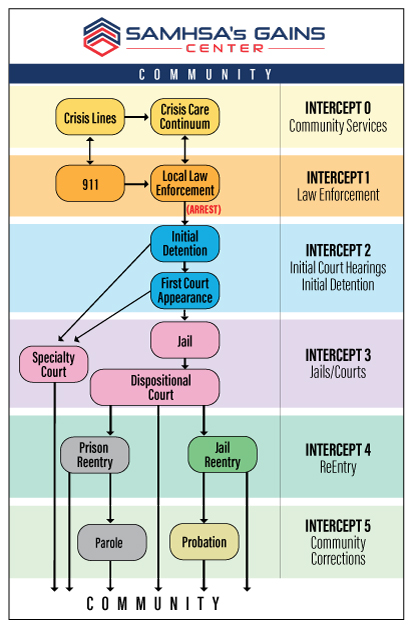The SIM helps communities identify resources and gaps in services at each intercept and develop local strategic action plans. The SIM mapping process brings together leaders and different agencies and systems to work together to identify strategies to divert people with mental and substance use disorders away from the justice system into treatment.
A SIM mapping workshop is available through SAMHSA’s GAINS Center for communities to:
- Plot resources and gaps across the SIM.
- Identify local behavioral health services to support diversion from the justice system.
- Introduce community system leaders and staff to evidence-based practices and emerging best practices related to each intercept.
- Enhance relationships across systems and agencies.
- Create a customized, local map and action plan to address identified gaps.

Intercept 0: Community Services
- Involves opportunities to divert people into local crisis care services. Resources are available without requiring people in crisis to call 911, but sometimes 911 and law enforcement are the only resources available. Connects people with treatment or services instead of arresting or charging them with a crime.
- Involves diversion performed by law enforcement and other emergency service providers who respond to people with mental and substance use disorders. Allows people to be diverted to treatment instead of being arrested or booked into jail.
Intercept 2: Initial Court Hearings/Initial Detention
- Involves diversion to community-based treatment by jail clinicians, social workers, or court officials during jail intake, booking, or initial hearing.
- Involves diversion to community-based services through jail or court processes and programs after a person has been booked into jail. Includes services that prevent the worsening of a person’s illness during their stay in jail or prison.
- Involves supported reentry back into the community after jail or prison to reduce further justice involve of people with mental and substance use disorders. Involves reentry coordinators, peer support staff, or community in-reach to link people with proper mental health and substance use treatment services.
Intercept 5: Community Corrections
- Involves community-based criminal justice supervision with added supports for people with mental and substance use disorders to prevent violations or offenses that may result in another jail or prison stay.


